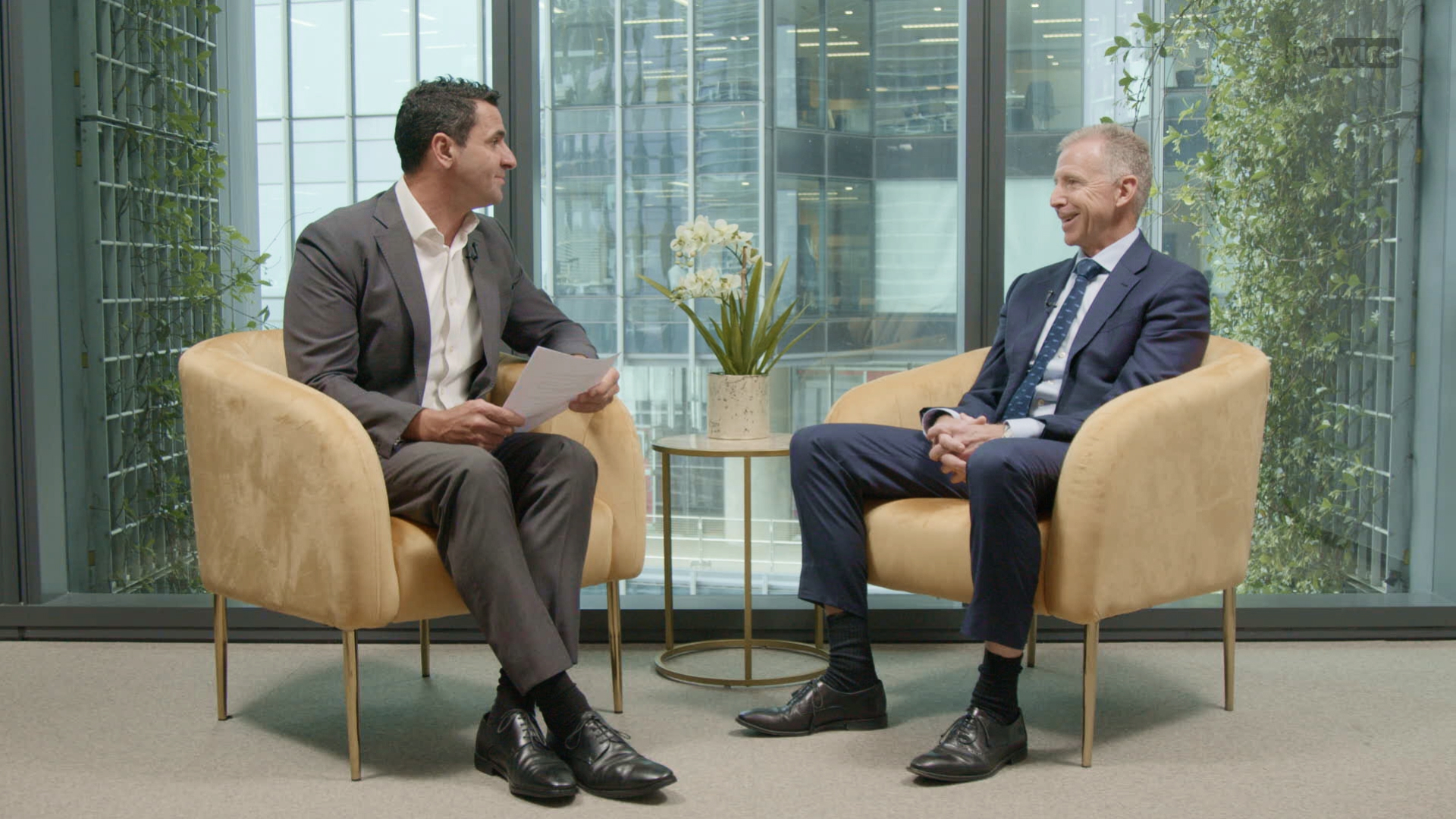The market is pricing in north of 100 bps of rate cuts in the next 12 months. Here’s why the market is wrong
The consumer is hurting, but Australia's economy continues to tick along, putting the RBA in a tricky position regarding monetary policy. Market expectations are that interest rates will fall by 100 bps or more over the next 12 months, but that is wishful thinking, according to Whitefield's Managing Director Angus Gluskie.
"If you read the papers, the headlines would tell you the conditions are dire. We don't think they're quite as dire as that. And, general economic conditions, at the least, they're moderate."
At the core of the issue for the RBA is persistent and sticky inflation, which Gluskie says is driven by the high cost of Australia's housing stock and the reality that additional supply will take a long time to hit the market.
Complicating the situation in Gluskie's view is that the RBA's primary tool for fighting inflation might not deliver the desired outcomes and, to an extent, could be a driver of further inflation.
"I think central bank monetary policy has its best effect when it's dealing with demand-driven inflation. That's not what we've got. We've got a situation of cost-push inflation, and unfortunately, that means that if the central bank raises rates, interest rates go up. It puts more pressure on consumers to demand higher wages. That could be inflationary. If they cut rates, that could push up housing prices more, which is a source of inflation for consumers."
Gluskie says he has given a lot of thought to the implications of this scenario, and he concludes that focusing on companies, such as Brambles (ASX:BXB), that can pass on price rises whilst avoiding rate-sensitive sectors is the playbook for an environment with persistent inflation.
Watch the full interview in this episode of The Pitch via the player above or read an edited transcript below.

Edited Transcript
We're going to be talking a little bit about the macro backdrop, the big picture, interest rates. First of all, what's the lay of the land from an economic perspective in your view, and I guess for the consumer on one side and also for the corporates on the other?
If you read the papers, the headlines would tell you the conditions are dire. We don't think they're quite as dire as that. And in fact, general economic conditions, at the least, they're moderate.
So if we look at some of the underlying factors that lead us to that conclusion, employment is very good in an historic sense. Unemployment is particularly low. Australia's got very strong population growth, which is giving impetus to the economy in quite a number of areas.
Government spending is strong in some key areas for our economy, such as education, healthcare, and also essential infrastructure. And if we look at our trading partners overseas, many other economies are in reasonably similar situations.
So overall, those conditions suggest that the economy is going okay. But look, against that, we do have to weigh up the fact that costs of living are higher for consumers, and that's certainly where the pain point is currently in the economy. The biggest costs of living are housing costs, rent, mortgage costs are high. We've had costs of living go up in other areas as well, and we're seeing that in high-measured inflation. It's higher now than it has been for several decades, and that is impacting on the consumer. So consumer spending volumes have been going down.
Markets are currently pricing in multiple rate cuts over the next 12 months. You've painted a relatively optimistic picture of the economy. Does that mean you're at odds with the market on rates?
Look, I think it's not impossible that we don't see some rate cuts. The RBA is concerned about the consumer, but I think there are limits to the type of rate cuts that might go through. We do believe that the Reserve Bank is facing a couple of challenges that it's having to weigh up. So just elaborating on that, if we think about the drivers of inflation that we've got at the moment, they're quite persistent. The house prices continue to be mentioned. And if we think about housing supply and demand, the demand equation is driven in part by population. That's not going to change quickly.
The supply, which is the building and construction of new houses, is something that takes years, if not decades, to alter. So while we've got that continued tightness in the housing market, house prices are likely to stay high, which means mortgage costs and rents are also likely to continue to put some pressure on the consumer.
So it's that kind of thought that suggests to us there's persistence in this consumer pressure, and it's worth remembering when there is that pressure on consumers, that translates into wage demands. Wage demands translate into rising prices of goods and services. So I think that's a tricky dilemma for central banks.
I think central bank monetary policy has its best effect when it's dealing with demand-driven inflation. That's not what we've got. We've got a situation of cost-push inflation, and unfortunately, that means that if the central bank raises rates, interest rates go up. It puts more pressure on consumers to demand higher wages. That could be inflationary. If they cut rates, that in turn could push up housing prices more, which itself is a source of inflation for consumers.
So look, that's a tricky equation for the central bank to balance. It's come about because we've had, I guess, a decade or more than a decade of very low interest rates that pushed house prices up relative to wages. And we now think we've got to go through quite a number of years where we can get wage levels rebalanced to housing prices so affordability is much better. And I think achieving that is going to require interest rates to be kept somewhere near where they are.
What could upend your view? What's the bear case?
Well, there's no doubt if conditions for the consumer deteriorated more calamitously, central banks would pay attention, and they would have no alternative but to prioritise resuscitating the economy instead of fighting inflation.
You've laid out your base case or your thinking on the outlook. What do you think it means for positioning and where investors can find opportunity? How does that translate to a portfolio level?
Yeah, look, it's one we've given a fair amount of thought to. We believe one of the better ways to position in this situation of slightly sticky inflation is to focus on quality, which you've heard us talk about before. However, we feel that companies with strong competitive positions in the industries in which they operate are best positioned to deal with the pressures of rising costs and also have the ability to pass on cost pressures if they need to. So that's a focus on quality, which we think is an important element. But interestingly, we're much more cautious about positioning too aggressively around consumer stocks or interest rate sensitives.
I think some of the reasoning behind that is that both the interest rate and inflation data tend to even flow; it's quite bouncy. And so stocks in those categories have experienced, and we think are likely to continue to bounce around as the data ebbs and flows, which means it's quite a dangerous place to play for investors. And equally, while it's tempting for investors to look at the complications for consumers and say, "Look, let's position away from consumer stocks." But it's worth remembering if central banks cut rates, those consumer stocks will be the first ones to bounce as central banks adjust their policy.
Could I get you to give me just an example of a company that you think has one of those defensive-style moats or the ability to pass on costs? And maybe give people some context also on one that's particularly sensitive to interest rates, just so they get a feeling for the types of companies you're talking about.
The property trust sector is one that's sensitive or viewed as being sensitive to interest rates. They have a level of borrowing as well as holding assets that are typically valued relative to interest rates. So people tend to favour them if they believe interest rates are being cut and get concerned as interest rates rise.
And they've had a good run over the past 12 months.
Well, they were initially sold off on concerns over COVID, so they had been cheap. But yeah, look, they've been coming back as, I guess, people start to look at that propensity for rate cuts to come through.
And on the quality side, a company that's got that ability to pass through price increases?
We've spoken in the past about Brambles (ASX: BXB) being well-positioned in the industries in which it operates. So its quality gives it some pricing power. And if I was thinking about other stocks with quite dominant industry positions, you'd think typically of large staple retailers. But look, they would usually be well-positioned for that, but right at the moment they're under a lot of scrutiny from a regulatory perspective. Maybe this time around, they will have less ability to move.

Whitefield Industrials is the longest operating LIC in Australia
Whitefield Industrials (WHF) is the longest operating listed investment company (LIC) in Australia, established in 1923. It holds a diversified portfolio of Australian industrial shares, including all sectors of the ASX 200 except the mining and resources sector.
Learn more here or please send us an email to hello@whitefield.com.au.
2 stocks mentioned
1 fund mentioned


